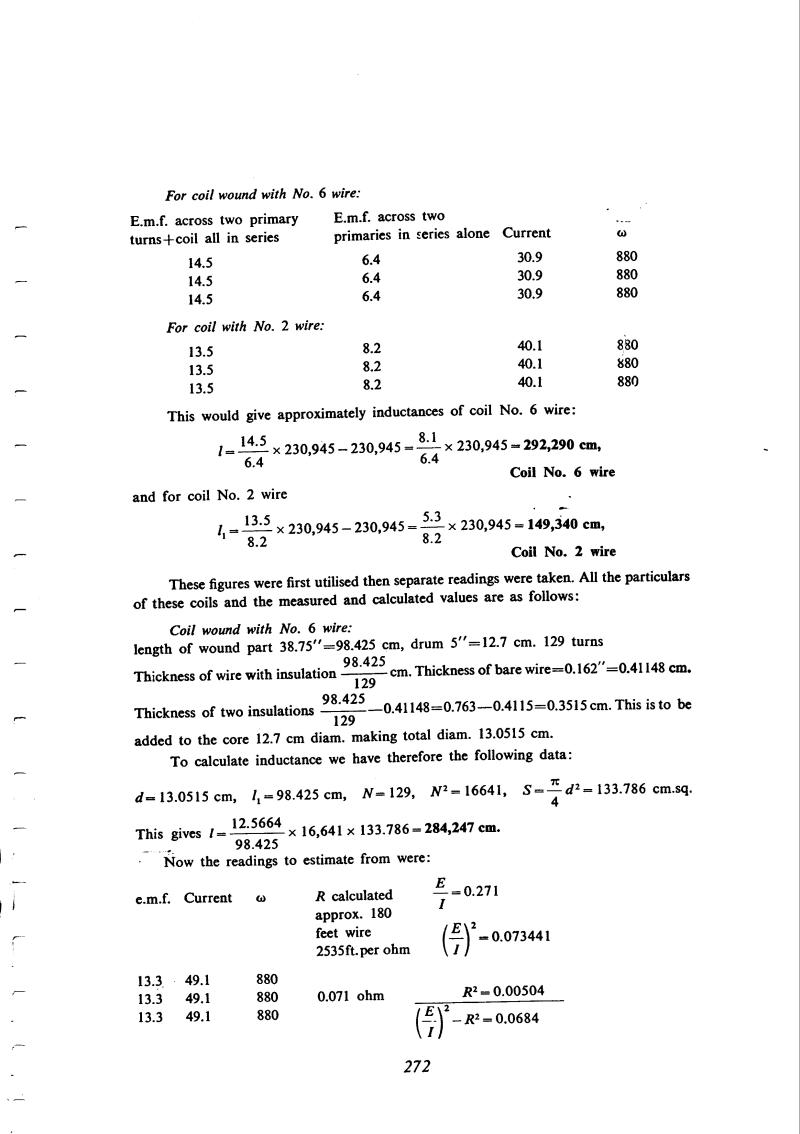
Nikola Tesla Books
For coil wound with No. 6 wire:
| E.m.f. across two primary turns+coil all in series | E.m.f. across two primaries in series alone | Current | Ï |
|---|---|---|---|
| 14.5 | 6.4 | 30.9 | 880 |
| 14.5 | 6.4 | 30.9 | 880 |
| 14.5 | 6.4 | 30.9 | 880 |
For coil with No. 2 wire:
| E.m.f. across two primary turns+coil all in series | E.m.f. across two primaries in series alone | Current | Ï |
|---|---|---|---|
| 13.5 | 8.2 | 40.1 | 880 |
| 13.5 | 8.2 | 40.1 | 880 |
| 13.5 | 8.2 | 40.1 | 880 |
This would give approximately inductances of coil No. 6 wire.
l = $! {14.5 \over 6.4} $! x 230,945 - 230,945 = $! {8.1 \over 6.4} $! x 230,945 = 292,290 cm,
Coil No. 6 wire
and for coil No. 2 wire
l1 = $! {13.5 \over 8.2} $! x 230,945 - 230,945 = $! {5.3 \over 8.2} $! x 230,945 = 149,340 cm,
Coil No. 2 wire
These figures were first utilized then separate readings were taken. All the particulars of these coils and the measured and calculated values are as follows:
Coil wound with No. 6 wire:
length of wound part 38.75" = 98.425 cm, drum 5" = 12.7 cm. 129 turns
Thickness of wire with insulation $! {98.425 \over 129} $! cm. Thickness of bare wire = 0.162" = 0.41148 cm.
Thickness of two insulations $! {98.425 \over 129} $! â 0.41148 = 0.763 â 0.4115 = 0.3515 cm. This is to be added to the core 12.7 cm diam. making total diam. 13.0515 cm.
To calculate inductance we have therefore the following data:
d = 13.0515 cm, l1 = 98.425 cm, N = 129, N2 = 16641, S = $! { \pi \over 4} $! d2 = 133.786 cm.sq.
This gives l = $! {12.5664 \over 98.425} $! x 16,641 x 133.786 = 284,247 cm.
Now the readings to estimate from were:
| e.m.f. | Current | Ï | R calculated approx. 180 feet wire 2535 ft. per ohm |
|---|---|---|---|
| 13.3 | 49.1 | 880 | 0.071 ohm |
| 13.3 | 49.1 | 880 | |
| 13.3 | 49.1 | 880 |
| $! {{E \over I} = 0.271} $! |
| $! {{\left({E \over I}\right)^{2}} = 0.073441} $! |
| $! {{R^{2} = 0.00504} \over {\left({E \over I}\right)^{2} - R^{2} = 0.0684}} $! |
272
November 9
He performs the interesting measurements of the mutual inductance on the basis of the primary inductance when the secondary is open, and in short circuit. He measured inductances at constant current and frequency so the calculation procedure is simplified. The obtained mutual inductance he compared with the inductance determined previously by means of induced voltage under no load conditions. Tesla thinks that the difference originates from the influence of the secondary on the primary when the secondary is open. In some cases for the purpose of oscillator operating frequency reduction Tesla used two separate coils which he did not name but designated by numbers. He compared the calculated and measured values for these coils. The measured value on the basis of voltage the ratio method amounts to approximately 2% less than values measured on the basis of voltage, current and frequency. The calculated values are smaller in both cases. The correction of measured values according to comment of Oct. 26 is not large (approximately 5%) because the ratio D/1 is relatively small.

